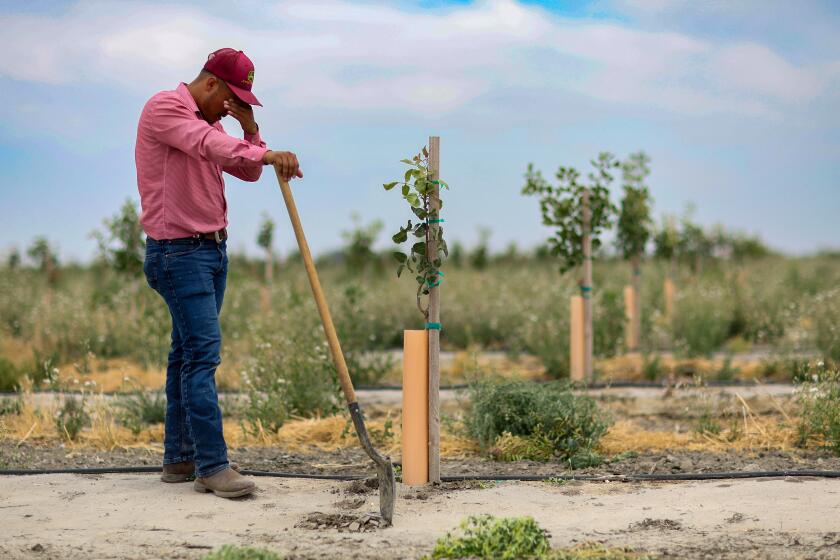Council Split Over Local Planning Panels : City Hall: Some say Joy Picus’ proposal to break up commission wouldn’t work. Others support her goal of more citizen participation.
A proposal by Los Angeles City Councilwoman Joy Picus to replace the citywide Planning Commission with four local bodies would be unworkable, expensive and unnecessary, some council members say.
But other members of the council say that the proposal, which Picus said is meant to make land-use planning more responsive to citizens, addresses the increasing frustration of some residents with city planning and should get serious attention, despite its shortcomings.
Under Picus’ proposal, unveiled last week, each of the mini-planning commissions would be composed of citizens appointed by the mayor. The commissions would oversee only the quarter of the city in which the members lived. The San Fernando Valley, she suggested, might have its own commission made up of local residents, as could the Westside, downtown and the Harbor area.
A previous effort to increase citizen participation in the planning process--the 1988 council decision to set up 35 planning panels citywide--stalled for lack of money, those involved in the process said.
“I think she’s really raised a good point, which is how to find a way to involve the community in a more immediate and meaningful way,” said Councilman Joel Wachs, whose 2nd District includes parts of the east San Fernando Valley. “We ought to use this as an opportunity to examine all the possibilities.”
Councilman Hal Bernson, who heads the council’s Planning and Land-Use Management Committee, agreed through a spokesman that the Picus proposal has merit.
In fact, Bernson, whose district covers the northwest Valley, has similarly suggested that the Planning Department create a separate Valley division and has championed the formation of citizens advisory panels to review development proposals.
Other council members said that although Picus’ goal of increasing citizen participation is laudable, her idea of how to accomplish it is badly flawed.
“It’s a good idea to decentralize the planning process and it’s a good idea to give neighborhood groups and private citizens more of a voice,” said Councilman Michael Woo, whose 13th District includes Studio City and parts of the eastern Santa Monica Mountains.
“But I think it is a bad idea to break up the Planning Commission because it would have the effect of encouraging the NIMBYs even more. We have a hard enough problem . . . with groups saying they have to have it their way.”
NIMBY, an acronym for Not in My Back Yard, is a catchword for opposition by neighborhood groups to any disruptive change, especially projects needed by the community as a whole, such as dumps, jails and mass transit.
The Picus proposal comes at a time when the city’s entire process of inventing itself and preparing for the future is being blamed for everything from air pollution to crime, from a lack of affordable housing to a dearth of mass transit. Mayor Tom Bradley and a consultant hired to look at the city’s Planning Department both have complained that politics, rather than sound land-use planning, often shapes development decisions.
In contrast to the mayor’s call for greater professional planning on a citywide basis, Picus said she wants to inject more local citizen participation, not less, into city planning.
“I believe very strongly that planning is part of the democratic process . . . ,” said Picus, whose West Valley district includes Woodland Hills and Canoga Park.
Picus, who sent up a trial balloon regarding the proposal last week at a meeting of a Woodland Hills homeowners group, which responded warmly to the idea, said she plans to submit it to the council within a few weeks. If the council endorses the proposal, it would have to be put to a vote of the people because it would require amending the City Charter.
Like the present five-member citywide panel, the local bodies would rule on development proposals or make recommendations to the City Council about a wide variety of planning issues and proposals.
Members of the Planning Commission have said that the proposal could make planning decisions subject to local popularity, rather than good planning. Moreover, citywide concerns--about issues such as traffic, the housing supply and jobs--would get short shrift, they said.
Others said the current system is not working as well as it should, but could be improved.
“Our system is not keeping up with the changes, and that is where the frustration is,” said Renee Weitzer, a planning deputy for Councilman John Ferraro, who represents Hancock Park as well as parts of the southeast Valley. She said Ferraro is concerned that Picus’ proposal would be expensive because it would require additional Planning Department staff and additional public hearings.
Councilwoman Ruth Galanter said she opposed the breakup of the Planning Commission because it would create more problems than it would solve. She endorsed, however, Picus’ goal of achieving greater citizen input and suggested that Picus set up informal advisory panels in her district to review development proposals as Galanter has in her district .
By establishing such panels, Galanter said, “she can achieve lots more democracy in planning in her district without waiting for a council motion.”
More to Read
Sign up for Essential California
The most important California stories and recommendations in your inbox every morning.
You may occasionally receive promotional content from the Los Angeles Times.






